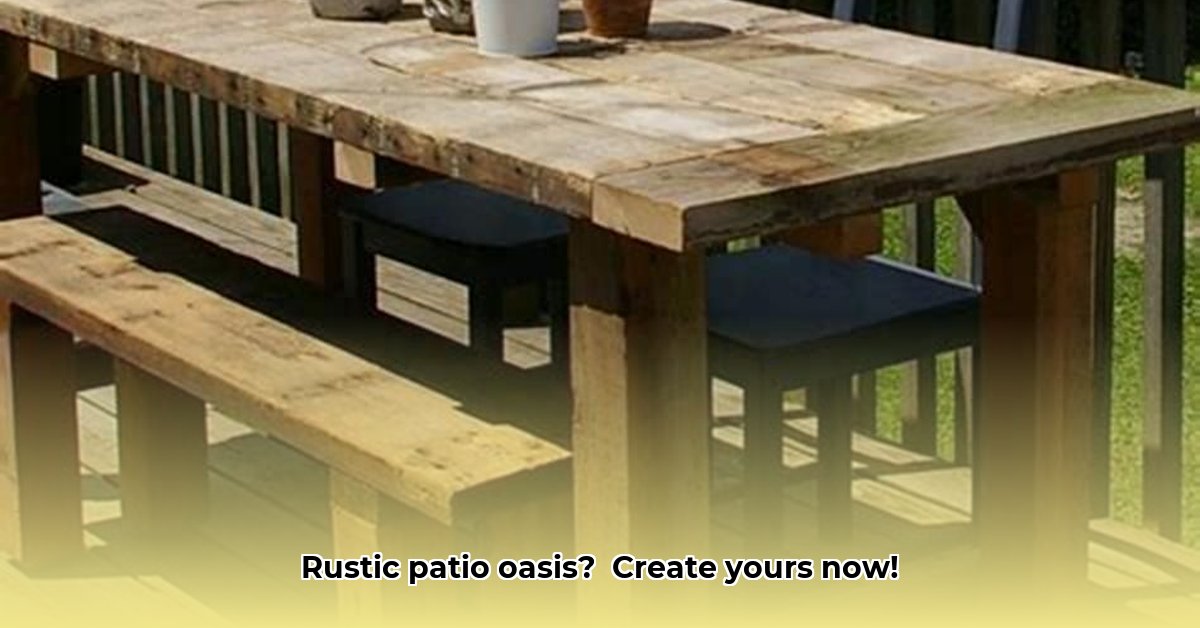Imagine yourself on a pleasant afternoon, enjoying a refreshing drink in the inviting embrace of your rustic patio. Making this vision a reality is easier than you think. This guide covers everything from selecting furniture to maintaining its charm for years. We’ll explore different styles, the pros and cons of various materials, and provide tips for choosing pieces that fit your space and budget. Think of this as your ultimate resource for creating the perfect outdoor haven. For even more inspiration, check out these rustic patio furniture options.
Designing Your Dream Outdoor Oasis with Rustic Patio Furniture
Creating a cozy outdoor retreat where you can relax with a book is attainable. Rustic patio furniture plays a significant role in designing the perfect outdoor relaxation space, from the initial selection to ongoing maintenance.
Exploring Rustic Patio Furniture Styles: Finding the Perfect Fit
Rustic patio furniture offers a wide range of styles to suit different tastes. Let’s explore some popular choices, keeping outdoor living decor in mind:
- The Enduring Appeal of Wood: Wood furniture, with its rich tones of redwood, the rugged character of reclaimed barn wood, and the weather resistance of cedar or teak, brings natural warmth and elegance to any patio. However, durability requires consistent care.
- The Light and Airy Charm of Wicker: Wicker, typically made from rattan or willow, provides a lighter, more open feel, creating a relaxed and inviting atmosphere. While more affordable than wood, wicker demands more attention. Opting for weather-resistant wicker is crucial in harsh climates.
- The Robust Elegance of Metal: Cast iron, wrought iron, and steel offer strong and stylish options. Powder-coated finishes enhance durability and weather resistance, ensuring a long-lasting choice. Be aware that metal can become extremely hot in direct sunlight.
Enhance your outdoor haven with these popular pieces:
- Swinging Benches: These add a playful touch and offer a relaxing spot to enjoy the outdoors.
- Adirondack Chairs: A classic for comfortable lounging.
- Fire Pits: Extend your outdoor enjoyment into cooler evenings.
Choose furniture that enhances your space and creates a welcoming environment.
Material Selection: Understanding Durability, Weather Resistance, and Maintenance
The choice of material significantly impacts the longevity and upkeep of your furniture. Let’s delve into durability, weather resistance, and maintenance explained:
| Material | Pros | Cons | Maintenance |
|---|---|---|---|
| Wood | Natural beauty, durable with proper care, adds warmth | Susceptible to rot, insect damage, and weathering | Regular cleaning, sealing (every 1-2 years), occasional refinishing |
| Wicker | Lightweight, versatile, often more affordable | Less durable than wood, prone to damage, requires protection from the elements | Regular cleaning, occasional repair or re-weaving |
| Metal (treated) | Durable, weather-resistant, low maintenance | Can overheat in sun, potential for chipping or scratching | Occasional cleaning, touch-ups for minor damage |
| Concrete | Extremely durable, modern aesthetic | Can be heavy and difficult to move, may require sealing to prevent staining | Regular cleaning with a mild detergent and water, sealing every few years |
| Recycled Plastic | Weather-resistant, durable, environmentally friendly | Can lack the aesthetic appeal of natural materials, may fade in direct sunlight | Easy to clean with soap and water, requires minimal maintenance |
This table offers a general overview. Actual durability and maintenance depend on the specific type of wood, wicker, or metal, as well as the quality of construction and finish.
Designing Your Ideal Patio: Key Considerations
Careful planning is essential before purchasing furniture. This will help you avoid mistakes and maximize your outdoor space. Consider these size, style, and budget considerations:
- Measure Your Space: Use a measuring tape to determine your patio’s dimensions, including walkways and access points. Create a simple sketch to visualize different layouts.
- Define Your Style: Gather inspiration from online sources or magazines. Decide on a style that reflects your taste and complements your home’s aesthetic.
- Establish a Realistic Budget: Prices for rustic patio furniture vary based on materials, craftsmanship, and retailer. Setting a budget beforehand helps prevent overspending. Investing in higher-quality pieces can save money in the long run due to their increased durability.
Maintaining Your Furniture’s Beauty: Practical Tips
With consistent care, your rustic patio furniture can maintain its beauty for years. Follow these care and maintenance tips:
- Regular Cleaning: Regularly sweep or brush away dirt and debris. For a more thorough cleaning, use a mild soap and water solution, rinse thoroughly, and let the furniture air dry.
- Protection from the Elements: Cover your furniture during storms, heavy rain, or snow with waterproof covers specifically designed for outdoor furniture.
- Sealing and Treatment (Wood Furniture): Protect wood furniture from moisture and UV damage by periodically sealing it. Follow the manufacturer’s instructions for the type of sealer and application method.
- Proper Storage: Store furniture in a dry, covered area during harsh winters or extended periods of disuse.
Finding Your Dream Furniture: Effective Shopping Strategies
Finding the perfect rustic patio furniture doesn’t have to be daunting. Explore both online and in-person shopping options, keeping these shopping tips in mind. Online retailers provide extensive selections and customer reviews. Local furniture stores and artisan workshops offer unique handcrafted pieces with a personal touch. Read reviews and compare prices before making a purchase.
Creating your dream rustic patio oasis is an investment in relaxation and enjoyment. By considering your style, budget, and space needs, you can transform your patio into a tranquil haven.
Selecting Sustainable Rustic Patio Furniture for Long-Term Enjoyment
Key Takeaways:
- The growing popularity of rustic outdoor furniture reflects a desire for natural aesthetics and a connection with the outdoors.
- Sustainable sourcing (FSC-certified wood, recycled materials) and durable construction are essential for long-term value and minimizing environmental impact.
- Increasingly, eco-friendly materials such as bamboo, recycled HDPE plastic, and sustainably harvested rattan are becoming available.
Consumers are increasingly prioritizing durability and quality, resulting in long-term investment.
Types of Rustic Patio Furniture and Materials
Ready to bring your dream outdoor oasis to life? Let’s explore different types of rustic patio furniture! The right style requires choosing the appropriate pieces.
We’ll examine various furniture types: sturdy tables, comfortable chairs, inviting benches, and relaxing swings. While each piece offers unique charm, the materials are paramount. Consider different wood types – the rich tones of teak, the rustic charm of cedar, and the durability of acacia. Wicker, rattan, and recycled metals offer sustainable alternatives. The material you choose will depend on your style and climate.
Choosing the perfect style begins with understanding your aesthetic preferences: Farmhouse? Cabin? Lodge? These aesthetics dictate your choice of materials and furniture styles. Do you envision a sleek, modern rustic look or something more traditional?
Material Durability and Weather Resistance
Durability is crucial for long-term outdoor use. Let’s examine some key material considerations for how to choose sustainable rustic patio furniture for long-term outdoor use:
| Material | Pros | Cons |
|---|---|---|
| Teak | Naturally weather-resistant, durable, develops a beautiful aging patina | Expensive, requires occasional oiling to maintain its color |
| Cedar | Aromatic, naturally resistant to rot and insects | Can warp or crack without proper treatment; requires regular maintenance to prevent weathering |
| Acacia | Durable, relatively affordable, sustainable sourcing options often available | More susceptible to weathering than teak; requires regular sealing to maintain its appearance |
| Recycled Plastic | Extremely durable, weather-resistant, low maintenance, environmentally friendly | May lack the aesthetic appeal of natural materials; potential for UV degradation over time |
| Wicker/Rattan | Lightweight, versatile, potential for sustainable sourcing | Requires careful treatment and storage to protect from rain and sun; less durable than wood; prone to wear and tear in harsh conditions |
| Aluminum | Lightweight, rust-resistant, durable, requires minimal maintenance | Can become hot in direct sunlight; may require cushions for added comfort |
Regardless of the material, proper maintenance is vital. Regular cleaning and seasonal care will extend the life of your furniture!
Furniture Selection for Your Space
Before purchasing, measure your patio to avoid buying furniture that is too big or too small. Consider the flow of traffic. Will there be enough space for comfortable movement?
Next, budget wisely. While high-quality, sustainable materials often have a higher upfront cost, their longevity makes them a worthwhile investment.
Finally, envision your ideal patio setup based on the materials you’ve selected. Combine style and functionality. Do you need a large dining table, a cozy conversation set, or a comfortable swing for relaxation?
Care and Maintenance for Long-Term Use
Proper care is essential for how to choose sustainable rustic patio furniture for long-term outdoor use. Here’s a maintenance plan to ensure your furniture lasts:
- Regular Cleaning: Dust and debris accumulate quickly.
- Colorful Backsplash Ideas: Brighten Your Kitchen With Tile - November 9, 2025
- Black Backsplash Ideas: Stylish Kitchen Transformations to Inspire You - November 8, 2025
- Dark Backsplash Ideas: Drama and Depth for Your Kitchen - November 7, 2025










